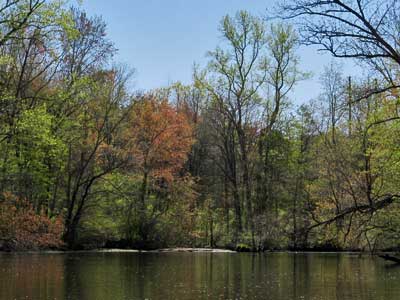On Maryland’s Eastern Shore, the Northeast, Elk, Chester, Wye, Sassafras, Miles, Tred Avon, Blackwater, Choptank, Nanticoke, Chicamacomico, Wicomico, Manokin, Anemessex, and Pocomoke rivers provide a wide range of activities.
The quality of fishing along any given stretch of river depends on the season, location, salinity, and other factors. Many Eastern Shore rivers sustain populations of largemouth bass, black crappie, sunfish, yellow perch, chain pickerel, channel catfish, bullheads, carp, longnose gar, and other species in their upper reaches. In the lower sections, striped bass, white perch, channel catfish, blue catfish, and a variety of saltwater species are common.
The major rivers of the Eastern Shore are fed by hundreds of smaller streams, creeks, and tributaries which sustain their own unique diversity of freshwater fish species. Many of these tributaries experience seasonal migrations of yellow perch, white perch, striped bass, American shad, hickory shad, and river herring.
Within several rivers’ upper watersheds are mill ponds and other impoundments. Most Eastern Shore mill ponds are relatively small. Many of these ponds and lakes have been dammed for hundreds of years and have diverse fish populations. Along their banks are cypress swamps, beds of spatterdock, ancient stumps and scattered fallen trees.
At the head of the Chesapeake Bay, the Northeast River flows the communities of Northeast and Charlestown before entering the bay near the Susquehanna Flats.
Near Elkton, Little Elk Creek, Big Elk Creek, and several smaller tributaries converge to form the Elk River. A few miles downriver, the Elk is joined by Back Creek, the western entrance to the Chesapeake and Delaware Canal. Further downriver, the Elk merges with the Bohemia River before emptying into the Chesapeake Bay at Elk Neck.
The Chester River begins near Millington. The river widens near Crumpton and passes through Chestertown, one of the region’s oldest waterfront communities. Below Chestertown, the Chester is joined by several smaller tributaries on its way to the Chesapeake Bay. Near its lower end, the Chester makes a hard turn northwest. Along this sharp curve are the communities of Queenstown, Kent Narrows, and Love Point.
Located west of Easton, the Miles River is famous for its blue crab populations. Along its bank, the historic town of St. Michaels provides a safe harbor for sailboaters, cruisers, commercial fishermen, and other travelers. Nearby, Knapps Narrows connects the Miles and Choptank Rivers.

On the upper Eastern Shore, Tuckahoe Lake drains into Tuckahoe Creek, which flows into the Choptank River. Near Cambridge, the Choptank River widens and flows towards the bay where it is joined by several smaller waterways.
At Blackwater National Wildlife Refuge, the Blackwater and Little Blackwater Rivers are dammed to create a maze of ponds, marshes, and channels. The area provides an important stopover for migrating waterfowl.
The upper Blackwater contains largemouth bass, black crappie, sunfish, chain pickerel, white perch, and other species. A northern snakehead fishery in the Blackwater River Watershed draws anglers from across the state.
A few miles to the south, the Transquaking and Chicamacomico rivers are also known for their unique fisheries. On both waterways, northern snakeheads are targeted extensively by anglers. In addition to snakeheads, both rivers are known for their largemouth bass, pickerel, crappie, white perch, blue catfish, channel catfish, carp, and other species.
The Nanticoke River contains important habitat for striped bass, white perch, shad, and other fish. Marshyhope Creek, a tributary of the Nanticoke, contains a variety of species including largemouth bass, crappie, sunfish, white perch, yellow perch, hickory shad, Atlantic sturgeon, blue catfish, channel catfish, bullheads, and northern snakeheads.
In Delaware, mill pond tailwaters and other small tributaries form the upper Nanticoke River Watershed. Access points are found along much of the Nanticoke. In Delaware, boaters can launch at Seaford, Woodland, Philips Landing, and other areas. In Maryland, facilities for boating and fishing are located at Sharptown, Vienna, Tyaskin, Bivalve, Nanticoke, Roaring Point, and Elliot’s Island.
The Wicomico River supports a wide range of fisheries. Its upper watershed is dammed in multiple locations, creating a series of lakes and millponds.
Near Salisbury, Johnson Lake, Leonard’s Pond, and Tony Tank drain into the Wicomico River. In Somerset County, Eden Pond drains into Wicomico Creek, a tributary on the lower Wicomico.
Near Salisbury, tidal bass fishing is popular, along with fishing for perch, catfish, and crappie. Along its mid-section, freshwater species give way to striped bass, white perch, catfish, and saltwater species.
From Mount Vernon to the mouth of the river, crabbing is popular. Commercial and recreational fishermen harvest blue crabs by trotlining and other methods.
In Somerset County, the Manokin, Big Anemessex, and Little Anemessex Rivers enter Tangier Sound near Crisfield Md. Their lower sections contain countless acres of marshes, feeder creeks, aquatic grass beds, oyster bars, beaches, and other fish habitats.
In Worcester County, the Pocomoke River is known for its fishing. Largemouth bass are found throughout the river. During spring, the upper river is noted for its shad runs while white perch are caught all along its path. In late summer and fall, saltwater species move into the lower river. During winter, anglers catch bass, chain pickerel, crappie, perch, and other species along stumps, channel edges and other structure.
Historic towns are located along the banks of Eastern Shore rivers. Once important ports for fishing and commerce, each town developed its own unique culture over the centuries. Although some towns are in decline, a few river communities have been successful in developing tourism-based economies.